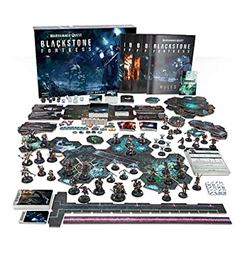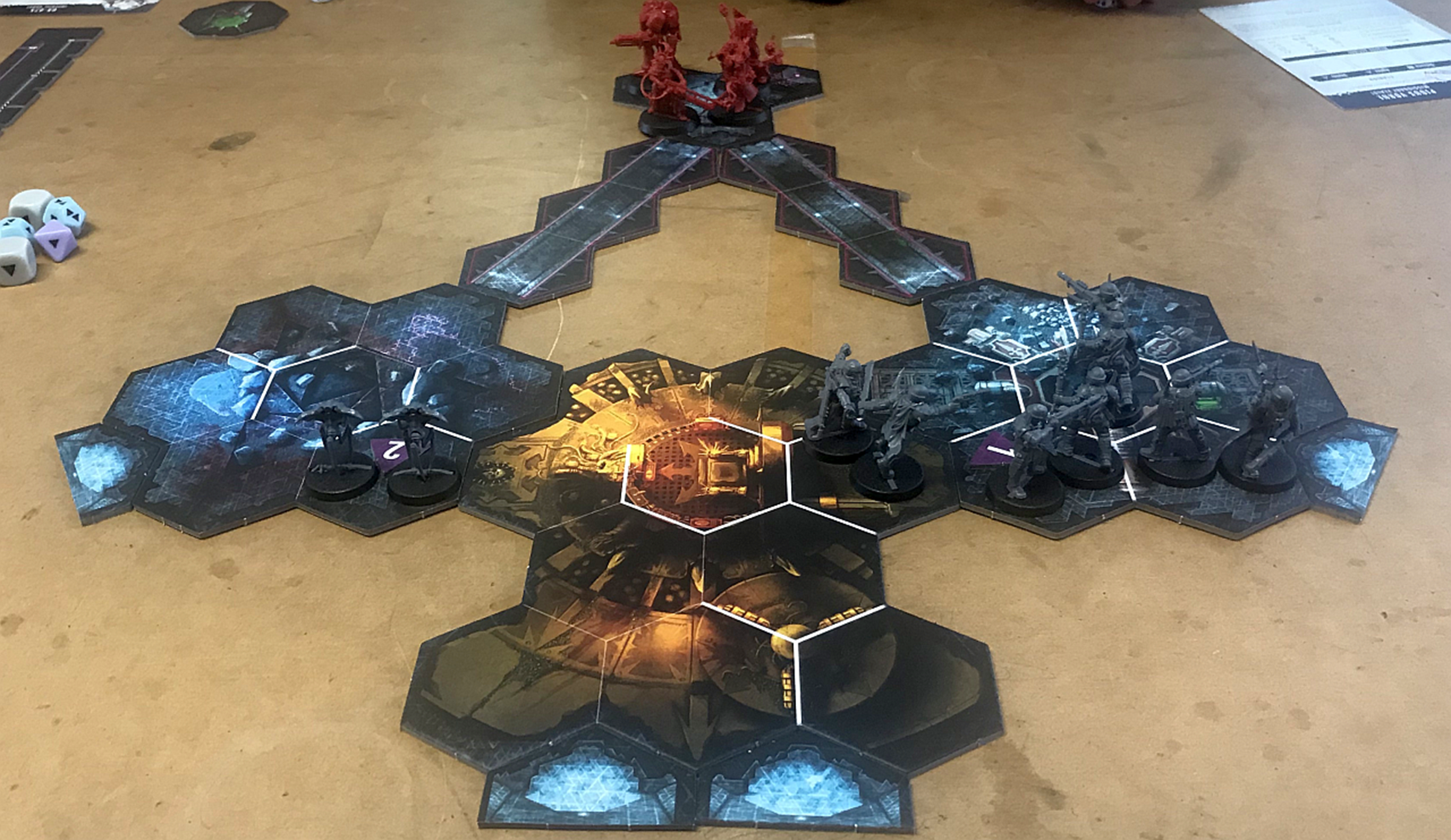 I played the new Games Workshop boardgame, Warhammer Quest: Blackstone Fortress on the weekend. There should probably be a 40K in there somewhere.
I played the new Games Workshop boardgame, Warhammer Quest: Blackstone Fortress on the weekend. There should probably be a 40K in there somewhere.
The game is designed for 1-4 players and is a co-operative quest against the game engine. In theory you can add a 5th player who makes decisions for the enemies, but that’s likely to be not particularly engaging for the fifth players, as they won’t have many decisions to make!
I found the game fascinating, with some marked changes to the rules compared to Warhammer Quest: Silver Tower and Hammerhal. The basis of the game is the same: the players control four characters exploring a massive spaceship. The players use dice to activate characters, with the number rolled on the dice restricting the type of action used. Wounds reduce the number of actions available to a character. However, many of the other mechanics (such as how combat is resolved) are subtly or not-so-subtly changed. It is fairly straightforward, however, and easy for people to learn.
Of note is that you don’t always lay out a map; the challenges you face are drawn from a seeded deck of cards. An expedition is up to four combats and four other challenges; you have the option of withdrawing after an encounter and not facing the rest. You use maps for combat challenges, which can be ambushes or meeting engagements.
The AI for the enemies is very interesting: you cross-reference the roll of a d20 with the current status of the figure (hidden, in cover, engaged, etc.) and then use the indicated strategy. There are small number of basic results, and some specials. What can be time-consuming about it is that roll (as I understand it) for each enemy; as there can easily be 12+ enemies on the board, this takes time. Less if I do it rather than a couple of my friends, admittedly. However, it allows the individual enemies to have interesting, not entirely predictable strategies, and I appreciate it. Each enemy type has a different table to roll on.
The initiative system for Blackstone Fortress worked well. The initial order is determined randomly by dealing out cards. Then, characters can swap with each other in the initiative order (each character can only swap once, so at most there can be two swaps.) Following that, PCs can attempt to swap their initiative with that of a monster’s. However, there is a cost: one of your four actions – and you’re not guaranteed of success, as you need to succeed at a skill roll. However, this can be very powerful, and it made navigating the initiative step a key part of good game play.
There’s also a light legacy component to the game. After each exploration, you draw a “Legacy” card that might alter what you face in future games. You have to finish the campaign before you draw all the Legacy cards. This may take some time! Our first expedition took us about 2.5 hours, in which we dealt with 5 of the 8 potential encounters – at that point, we’d accumulated the 4 clues we needed to find a stronghold.
The goal of the game is to find and explore the vault. To find the vault, you need to explore four strongholds. To find a stronghold, you need to find four clues first. I don’t think you can find clues in strongholds, so that’s a lot of regular expeditions to mount! If you assume that it takes an expedition to find the four clues (you might find more, but anyway), that’s 9 game sessions of 2+ hours to complete the entire thing.
The big question is “Does the play get repetitive?”, which is not something I can answer yet. It might end up being a grind. For a regular expedition, you face up to four challenge encounters and four combat encounters, randomly selected from 18 challenges and 18 combats. The combat encounters give a floor plan plus the initial positions of monster groups, but the monster groups are further randomised. In your initial explorations, there are only four types of monsters available, but more can be unlocked with expansions.
What’s in the Vault? It’s in a sealed envelope! Ooh!
Games Workshop plan to release several expansions, giving further secrets to find on the ship. This could be a lot of fun!
As you might expect, the bits in the game are very nice. 44 miniatures, lots of cardboard deck pieces and cards, a bunch of dice, and several rulebooks. Rules are quite simple and easy to pick up. One very nice touch is the nine durable plastic pouches to store your characters between missions. I also like that there are “Mortis” cards to store with characters after they die – you have to use another character in the next mission!
The miniatures must be assembled, and they come unpainted. No glue is required to assemble them – I didn’t use any on mine – but a set of clippers to remove them from the sprues is essential.
So, those are my initial thoughts on Warhammer Quest: Blackstone Fortress.

